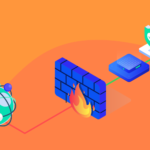Delve into the intricacies of a Layer 4 firewall, also known as a network firewall, operating within the transport layer of the OSI model. Explore its effectiveness in traffic control, limitations in understanding specific applications, and the fundamental security it provides.
Before we dive in, we’d like to inform you that we offer Cloud servers with this Firewall protection. If interested, you can visit our website to discover more about our Cloud features.
Title: Layer 4 Firewall: Securing Transport Layer Traffic
Introduction In the realm of network security, the Layer 4 firewall stands as a sentinel within the transport layer of the OSI model. This blog delves into its operation, focusing on traffic control based on packet headers. Let’s unravel the layers of security it provides while recognizing its limitations in understanding specific applications.
Understanding the Transport Layer Firewall
A foundational understanding of the OSI model lays the groundwork for grasping the role of a Layer 4 transport firewall.
- Transport Layer Dynamics: Unpacking specific details of the transport layer elucidates the operational domain of the firewall.
- Examination of traffic control strategies based on packet header information reveals the firewall’s effectiveness.
Limitations in Application Understanding
Delving into the firewall’s limitations sheds light on its inability to comprehend specific applications fully.
Exploring the basic security level offered by the firewall through IP addresses and port rules.
A Layer 4 firewall, also known as a network firewall, operates at the transport layer of the OSI model. This type of firewall focuses on controlling and managing traffic based on information contained in network packet headers. While effective in allowing or blocking traffic based on established filtering rules, its ability to understand specific applications is limited. A Layer 4 firewall provides a basic level of security by examining information in network packet headers and applying rules based on IP addresses and ports, without delving into the specific content of data or applications.
a. Overview of the OSI Model
The OSI model, a conceptual framework for network communication, consists of seven layers. At Layer 4, known as the transport layer, our firewall operates. Understanding the OSI model is crucial to comprehend how this firewall seamlessly integrates into the network architecture.
b. Transport Layer Dynamics
The transport layer manages end-to-end communication and ensures data integrity. Our firewall leverages this, focusing on packet headers to effectively control and manage traffic. This specific layer approach enhances its accuracy in regulating data flow.
c. Traffic Control Mechanisms
Efficiency is the hallmark of a Layer 4 firewall. By scrutinizing packet headers, it adeptly allows or blocks traffic based on predefined filtering rules. This granular control mechanism ensures optimal network performance while safeguarding it from potential threats.
d. Limitations in Application Understanding
While excelling in traffic control, this firewall has limitations in understanding specific applications. Unlike higher-layer firewalls, it does not delve into data or application content. Recognizing this limitation is vital for a holistic view of its capabilities.
e. Fundamental Security Measures
A Layer 4 firewall provides a fundamental level of security. By examining packet header information and applying rules based on IP addresses and ports, it establishes a barrier against unauthorized access. Though lacking in-depth content inspection, its fundamental security measures are robust.
Practical Applications of Layer 4 Firewall
Bringing theoretical knowledge into practical contexts, this section explores real-world scenarios where a Layer 4 firewall plays a vital role. From managing network traffic in large enterprises to securing small-scale configurations, its adaptability shines through.
Here are some examples of possible implementations based on Layer 4 Firewalls:
- Web Hosting Solutions: Layer 4 firewalls are commonly used in web hosting solutions to ensure server and website security. Here are some typical scenarios for implementing a Layer 4 firewall in web hosting solutions:
- Web Server Protection: One of the most common scenarios is protecting web servers against malicious attacks, such as Distributed Denial of Service (DDoS) attacks or unauthorized access attempts. The Layer 4 firewall can filter incoming and outgoing traffic to block or limit unwanted access.
- Port Access Control: Layer 4 firewalls allow controlling which ports are open and who can access them. This is essential to ensure that only necessary web services are publicly available and to prevent intrusion attempts on other ports.
- Load Balancing and High Availability: Layer 4 firewalls are used to distribute traffic among multiple web servers (load balancing). They can also be configured to ensure the high availability of web services by automatically redirecting traffic to secondary servers in case of primary server failure.
- Malicious Traffic Filtering: These firewalls can detect and block malicious traffic, such as packets with harmful content or brute force attacks through known ports. This helps protect web applications and servers against common threats.
- Network Segmentation: Layer 4 firewalls allow creating virtual network segments, making it easier to separate services and applications into different networks. This improves security by limiting communication between different components of the web hosting infrastructure.
- Inbound and Outbound Traffic Management: They can be used to control both incoming and outgoing traffic, helping prevent data leaks and ensuring that only legitimate traffic is allowed out of the server.
- Activity Monitoring and Logging: Layer 4 firewalls often feature logging and monitoring functions that allow administrators to track network activity and detect abnormal patterns or intrusion attempts.
Common Concerns and Solutions
Security concerns are paramount to all users. Here, we address the most common concerns related to the Layer 4 firewall, providing insights and solutions. From configuration challenges to rule set optimization, we guide users to maximize the firewall’s effectiveness.
- Port Access Control: Layer 4 firewalls allow controlling which ports are open and who can access them, thus preventing unauthorized use of unauthorized ports.
- Malicious Traffic Filtering: They can detect and block malicious traffic, such as packets with harmful content or brute force attacks through known ports.
- Protection against Port Scanning: Layer 4 firewalls can detect and block port scans, which are a common precursor to cyberattacks.
- Network Segmentation: They help separate services and applications into different virtual networks, thereby limiting communication between infrastructure components and reducing the risk of security breaches.
- Inbound and Outbound Traffic Management: They can control both incoming and outgoing traffic, helping prevent data leakage and ensuring that only legitimate traffic is allowed out of the server.
- Flood Attack Prevention: They can block flood attacks, such as SYN flood attacks, which attempt to exhaust server resources.
- Reduction of Attack Surface: By limiting exposure to unnecessary ports and services, Layer 4 firewalls reduce the potential attack surface.
FAQs (Frequently Asked Questions)
- How does a Layer 4 firewall differ from higher-layer firewalls? While higher-layer firewalls inspect content, a Layer 4 firewall focuses on packet headers, providing effective traffic control without delving into application-specific details.
- Can a Layer 4 firewall protect against advanced cyber threats? While it offers fundamental security, it may not provide complete protection against advanced threats. Complementary security measures are recommended for a robust defense.
- What are the key considerations when configuring a Layer 4 firewall? Configuring IP addresses, ports, and filtering rules is crucial. Regular updates and monitoring ensure optimal performance and security.
- Does a Layer 4 firewall impact network speed? When properly configured, the impact on network speed is minimal. Efficient traffic control mechanisms contribute to seamless data flow.
- Can it adapt to the evolving cybersecurity landscape? Regular updates and awareness of emerging threats are essential for the firewall to adapt and remain effective in the dynamic cybersecurity landscape.
- Is a Layer 4 firewall suitable for small businesses? Yes, its effectiveness in traffic control and fundamental security make it suitable for small business configurations, offering a balance between protection and performance.
Conclusion
A Layer 4 Firewall, a stalwart of the transport layer, provides a fundamental level of security. Its effectiveness in traffic control and fundamental security measures make it a valuable component in network defense. Understanding its strengths and the reasons for implementing Layer 4 Firewall-based security systems is essential for addressing a security project and enhancing the entire infrastructure needed for our Internet services and solutions.
SW Hosting specializes in these types of services, embedded in all Cloud and Hosting services in its catalog. In fact, if you wish, you can hire a Cloud server with a Layer 4 Firewall immediately, or access more information about our servers.







